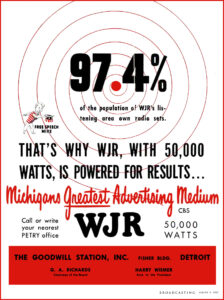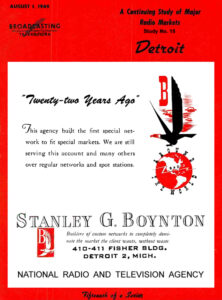 75 Years Ago, This Month, Broadcasting Magazine Reported In-Depth On the Status of the Radio Market in Detroit, Michigan
75 Years Ago, This Month, Broadcasting Magazine Reported In-Depth On the Status of the Radio Market in Detroit, Michigan
Note: Missed Chapter Three? Go HERE.
_____________________
The agency’s oldest active radio account is Schmidt Brewing Co., user of available spots before or after sports events. This account got one of the greatest bargains in radio history last fall when it bought a package deal of the AM rights for the Stanley Cup hockey games. The first game of the series, instead of ending in one hour, went more than two hours overtime, and permitted more than 100 commercials. Naturally, copy wasn’t written for even a great part of that number, and partner Simons wound up dictating new ones over the phone to the waiting announcers at Olympia Stadium. Schmidt is now buying spots on each of the three TV stations, plus a steady schedule of AM spots.
 Simons-Michelson also placed Benrus Watch spots before the World Series games last fall, on every available station on a one-time buy. It instigated the Wheaties five-minute sports program before leading football games all over the country-pro, college, even high school or semi-pro if the game had generated enough interest in a specific area. Unfortunately, the football season was just a little too late in the year to do a good selling job on a cold cereal, and the idea was dropped.
Simons-Michelson also placed Benrus Watch spots before the World Series games last fall, on every available station on a one-time buy. It instigated the Wheaties five-minute sports program before leading football games all over the country-pro, college, even high school or semi-pro if the game had generated enough interest in a specific area. Unfortunately, the football season was just a little too late in the year to do a good selling job on a cold cereal, and the idea was dropped.
[Note: Mouse click over (pc) or tap and stretch (mobile screen) over the WJR ad image for largest detailed read.]
Pepsi-Cola is a heavy spot buyer in the Detroit area. Dossin Food Products is the local bottler, and at present is also using the Ty Tyson 10- minute sports show. One of the outstanding success stories in the food line is that of Velvet Peanut Butter. A comparative newcomer to the field, Velvet now ranks as the largest selling brand in Michigan despite the competition of national names.
This preference for radio has been built in part by the Floyd Rice account, local Ford dealer, which claims to buy and sell more used cars than any new car dealer in the world. About 75% of its budget is put into radio, especially spots, with emphasis on nearness to sports programs. Occasionally it buy sports shows. The agency also handles the Plymouth Dealers of both Detroit and Cleveland. The Detroit organization sponsors the early morning traffic program, Listen and Live, built around music, with a representative of the police department giving pertinent data on traffic, weather and driving conditions for the a.m. drive to work.
During last fall’s Plymouth model changeover, the Detroit dealers used twice as much point of sale display as they did radio, but when the 1949 Plymouth was introduced this year, the program had swung to 100% radio. In Cleveland, a saturation schedule was put on all stations, using over 400 spots in two weeks. Two other active auto accounts are Park and Jefferson Motors, Lincoln-Mercury dealers who buy a half-hour newscast once a week.
An instance of a product catching on with the use of radio through Powell-Grant is Miracle-Power, an engine conditioning product made by the A. P. Parts Corp. of Toledo. Another “off-trail” advertiser is the Southeastern Michigan Tourist Assn., which uses mid-week spots to buck up business in resorts that are having dull times, to pull out-state residents into the Detroit area, and Detroiters into the vacation-land along the eastern shore, north of the city. The association claims it can see a response the next weekend to spots placed on Wednesday. Lee & Cady, wholesale grocer, uses chain breaks to ‘satisfy retailers’ demands for product backing up. A furniture retailer, Fenster’s, uses spot radio in three-day buys when the store holds sales. Robert H. Powell is head of Powell-Giant, with Pat Freeman in charge of radio buying.
One of the outstanding users of radio in this area has been the Goebel Brewing Co., which has expanded distribution to the point where it now advertises as “Detroit’s National Beer.” Through Brooke, Smith, French & Dorrance, Goebel sponsors the AM broadcast of all Tiger games, at home and away, over the Goebel network, a regional buy of over 30 stations, including WJBK and WKMH in suburban Dearborn. In addition, the brewery is telecasting some 35 home games over WWJ-TV. To round out baseball activities, it is active in Chicago, telecasting the Cubs’ games over WEN-TV.
Willard S. French is president of the agency and Guy C. Smith is secretary-treasurer. Other active radio accounts are Iron-Rite Ironers, of Mt. Clemens, Mich., now buying the five minute TV show, Petticoat Lane on WJBK-TV and using occasional AM spots, and Youngstown Kitchens, who plan using a TV test program in the near future.
Hugh Hole is BSF & D radio director, with Clyde Vortman as time buyer. This agency is housed in an Italian Renaissance mansion on East Jefferson that once belonged to the Book family and was a landmark in Detroit’s social life.
Like BSF & D, Jefferson avenue is the home of Maxon Inc., which is housed in two buildings, one the lovely old Barbour family home which contains the media and research departments, and a few hundred feet away, the former building of George Harrison Phelps, a pioneer Detroit broadcaster and ad-man, which now houses executive offices and production facilities. No. 1 radio account of this nationally known agency is the Gillette Safety Razor Co., which sponsors most of the major sports events of the year, including the World Series and the Triple Crown of racing, plus the fights from Madison Square Garden. However, the billing of this account and purchases of time are handled through the N. Y. office, under the direction of Preston H. Pumphrey, and Ed Wilhelm, time buyer. This is also true of the recently begun spot campaign of the H. J. Heinz Co., another giant Maxon account, which is being continued. (In spite of the recent N. Y. Times ad of the American Newspaper Advertising Agency). Searle Hendee, vice-president` of the agency, is account-executive on Gillette.
The chief local radio account of this agency, whose president and founder, Lou R. Maxon, is as well known for his unpublicized charities as he is for his meteoric rise in the advertising world, is that of the Pfeiffer Brewing Co. Currently, this company is using an hour-long 1 a.m. show on WJR, featuring records beamed at stay-up-laters, plus a steady schedule of spots on 53 Michigan stations. The increased advertising of this brewery is in great measure responsible for its recent vault into first place in beer sales in the state. On a slightly smaller scale is the spot campaign being used nationally by Drewrys Ltd. for their beer and ale. Both Of these accounts favor chain breaks and best available spots.
Stockwell & Marcuse is another Detroit agency that has been quite active in the radio and television field. Sam’s Cut Rate, a local department store client, has sponsored the Detroit Symphony and has been a large spot buyer in the past. The agency telecasts pictures of actual homes for sale for Homer Warren & Co., local realtor. It claims a first in bringing a political figure to the TV mike in Detroit in a paid telecast.
Another advertising agency handling radio accounts is Howard D. Steere Advertising with offices at 2812 Book Tower. Howard D. Steere is owner of the firm.
In the institutional field, Stockwell & Marcuse handles the Industrial National Bank, which sponsors the local broadcast of the Ronald Colman half -hour drama. Another steady user of spots is the Michigan Automobile Club, AAA representative in the state. William Stockwell and Philip R. Macuse head the firm, with Mr. Stockwell handling time buying.
One of the oldest firms handling local accounts is Luckoff, Wayburn & Frankel, which evolved from Bass-Luckoff, founded in 1928. One of the original partners, Louis Bass, left Detroit and established a new firm, Bass-Luckoff of Hollywood. Lou Luckoff, senior partner of L, W & F, is a strong supporter of radio, especially spots. He says: “We find that a consistent program of spots, properly used, can go a long way in increasing volume. The key phrase is, properly used.” And he backs his statements with time buys, too.

Another leader in the local field is the Rex Advertising Co., who estimate their radio and TV billings as ‘70% of the agency total. Under the direction of Fred A. Epps, president, and Jack Trustman, v.n. in charge of radio and TV production, this agency has had to change locations three times in as many years, each time doubling space used. They are producing the half hour Club HADA TV show for the Hamtramck Auto Dealers Association, which features talent from the Bowery night club, plus guest stars, in a variety show. This association, whose members are in violent competition with each other, joined hands two years ago in an endeavor to publicize their Auto Row and to win business away from world-famed Livernois Avenue. One of the dealers, Krajenke Buick, in addition just signed a 52-week contract with WJBK-TV for a televising of western serials. Woody Pontiac, and Harley Buick are TV spot buyers. In the AM field, chief spot buyers are Lasky Furniture, Clark Auto Sales, and Kowalski Sausage.
A unique success story is recorded by the Broadway Market, one of the oldest markets in the area, located in the heart of downtown. With the rise of supermarkets in neighborhood areas, business had been falling off badly. The 34 different concessionaires who had booths in the market held a meeting and called in Mr. Luckoff, asking his advice on the spending of a $25,000 appropriation. MCRFB: to be continued next week . . . .
This feature is a special Broadcasting series about Detroit radio. This report was first printed by the publication, August 1, 1949. This exclusive presentation has continued every Tuesday on this site beginning in August. The last two chapters of this series will be posted two weeks — Tuesdays — into September, for a total of six weeks.
Originally published in Broadcasting magazine under the title “The Detroit Radio Market,” this extensive article will be presented in six parts, in sequential chapters.
The 1949 article provides valuable insights into the state of radio in Detroit during the late 1940s decade, as it was, then, seven decades ago.
![]()








